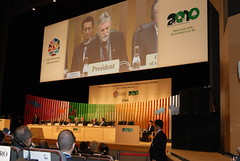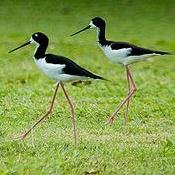 2010年是國際生物多樣性年,由於許多物種正以從未想過的數量消失,所以現在迫切需要進行協商。因此,聯合國18日起於名古屋開始的生物多樣性大會,背負著發展新策略以停止生物多樣性流失的使命。聯合國生物多樣性公約的執行秘書朱格拉夫(Ahmed Djoghlaf)在開幕演講中即警告,目前物種滅絕的速率比自然狀態下要快1千倍,現在正處於一個「頂點」,一旦越過就再也無法逆轉。
2010年是國際生物多樣性年,由於許多物種正以從未想過的數量消失,所以現在迫切需要進行協商。因此,聯合國18日起於名古屋開始的生物多樣性大會,背負著發展新策略以停止生物多樣性流失的使命。聯合國生物多樣性公約的執行秘書朱格拉夫(Ahmed Djoghlaf)在開幕演講中即警告,目前物種滅絕的速率比自然狀態下要快1千倍,現在正處於一個「頂點」,一旦越過就再也無法逆轉。
根據世界自然保育聯盟(IUCN)統計,全球5,490種哺乳動物中,有78種已經在野外滅絕,188種極度瀕危,450種處於瀕危狀態。IUCN表示,棲地的喪失、過度開發、污染、疾病以及人類引起的氣候變遷都是造成這些物種滅絕的因子。
儘管人類未能達成在2010年減緩全球生物多樣性喪失的目標,此次古屋任務是:以2050年為遠景設定為期10年的「愛知-名古屋策略計畫」。朱格拉夫說,「這不是另一個計畫而已,根據上個月在紐約的生物多樣性高峰會建議,這將是包含聯合國系統在內,對全球生物多樣性工作整體框架進行總體協調的計畫。」
 聯合國環境計畫署執行主任史坦納(Achim Steiner)也表示,「動植物、真菌、微生物等製造並且清靜我們所呼吸的空氣,產生水作為發電、灌溉和飲用,提供食物、住所以及藥品,也帶來許多歡樂以及我們每天精神生活的所需,現在如果不是為他們,也是為了我們自己的緣故,這些供應者在第十屆締約國會議中,需要極大的援助。」
聯合國環境計畫署執行主任史坦納(Achim Steiner)也表示,「動植物、真菌、微生物等製造並且清靜我們所呼吸的空氣,產生水作為發電、灌溉和飲用,提供食物、住所以及藥品,也帶來許多歡樂以及我們每天精神生活的所需,現在如果不是為他們,也是為了我們自己的緣故,這些供應者在第十屆締約國會議中,需要極大的援助。」
國際鳥盟,世界最重要的鳥類保育組織,與其分布在100多個國家與地區的合作夥伴,概述了5個名古屋會議必須達成的目標,這些目標是:
1.採取與2020年目標相關,全面、重大且可實現的策略計畫,超越過去的方式。
2.採用同意機制,以確保每個國家在實行生物多樣性公約的時候,可以取得所有需要的資源。
3.協商的結果須達成國際間取得與利益共享(Access and Benefit Sharing)機制,一套在締約國之間具有法律約束力的管理制度。
4.同意擴大保護區網絡,特別是海洋區域。
5.在生物多樣性公約以及聯合國氣候變遷框架公約之間,在國內與國際間同意採取明確的行動。
 「全球生物資源──像是雨林、珊瑚礁以及農業生物多樣性──正持續下降,增加了貧窮的威脅,使人們在氣候變遷之下更顯脆弱,」國際環境與發展研究所的資深研究員羅伊(Dilys Roe)說道,他是國際鳥盟發表的免費新書《生物多樣性:脫離貧窮的自然之道(Banking on biodiversity: a natural way out of poverty)》的共同作者。
「全球生物資源──像是雨林、珊瑚礁以及農業生物多樣性──正持續下降,增加了貧窮的威脅,使人們在氣候變遷之下更顯脆弱,」國際環境與發展研究所的資深研究員羅伊(Dilys Roe)說道,他是國際鳥盟發表的免費新書《生物多樣性:脫離貧窮的自然之道(Banking on biodiversity: a natural way out of poverty)》的共同作者。
朱格拉夫,施泰納和非政府組織緊急呼籲所有在名古屋的政府代表們,敲定一項具有法律約束力的協議,這項協議與取得遺傳資源以及共享取得的資源有關,稱為取得與利益共享(ABS)。
該公約規定,個人或機構在國外由生物資源尋求取得遺傳物質時,必須先行知會該國。該個人或機構尋求取得過程時,也必須經過談判協商並取得同意使用該資源的條款與條件。
遺傳資源通常被研究所、大專院校、私人製藥公司、農業與園藝界、化妝品與生物科技業用來進行研究與產品開發。
在10月25-26日,名古屋高階會談之前,122位來自世界各地的立法者將與環球國際組織(GLOBE International),環球國際日本(GLOBE Japan)分布以及生物多性公約秘書處共同召開一個論壇。論壇焦點將放在自然資本的概念,作為把生物多樣性以及生態系統服務的主流,納入政策決策的手段。
A new strategy to halt the loss of the Earth's diverse living beings is expected to emerge from a United Nations conference that opened Monday in Nagoya. As 2010 is the International Year of Biodiversity, there is an urgency to these negotiations because species are disappearing in unprecedented numbers.
Species extinction rates are now as high as a thousand times the natural rate, and the world is nearing a "tipping point" where there could be irreversible loss, warned Ahmed Djoghlaf, the executive secretary of the UN Convention on Biodiversity, in his opening speech to the delegates.
Of the world's 5,490 mammals, 78 are Extinct or Extinct in the Wild, with 188 Critically Endangered and 450 Endangered, according to the International Union for the Conservation of Nature. Habitat loss, over-exploitation, pollution, disease and human-induced climate change are the factors driving these extinctions, the IUCN says.
Although the world failed to meet its 2010 target of slowing the loss of global biodiversity, the delegates gathered at Nagoya are tasked with setting another target, to be embodied in the Aichi-Nagoya Strategic Plan for the next decade, with a vision for 2050.
"This is not another plan," said Djoghlaf. "It will be, as recommended by last month's historic New York summit on biodiversity, the overarching coordinated global biodiversity framework of the whole biodiversity family, including the United Nations system."
"The plants and animals, fungi and micro-organisms that produce and clean our air, generate drinking water, hydro-power and irrigation; provide food, shelter and medicines and also bring to many joy and a spiritual dimension to our daily lives need a big helping hand from this 10th Meeting of the Conference of the Parties - if not for their sakes, for ours," Steiner said.
BirdLife International, the world's foremost bird conservation group with partners in more than 100 countries and territories, outlined five essential goals the Nagoya conference must meet to be successful.
The conference must:
● adopt a comprehensive, ambitious and achievable strategic plan with associated 2020 targets that take us well beyond business as usual
● agree mechanisms to ensure that each country has access to the resources it needs for effective implementation of the Convention on Biodiversity
● conclude negotiations on the international Access and Benefit Sharing, ABS, regime resulting in a Protocol to the Convention with legally binding provisions
● agree to expand protected area networks, particularly in marine areas
●agree clear actions to promote synergies between the Convention on Biological Diversity and the UN Framework Convention on Climate Change at national and international levels
"The ongoing decline of the world's biological resources - such as rainforests, coral reefs and agricultural biodiversity - threatens to increase poverty and people's vulnerability to climate change," said Dr. Dilys Roe, a senior researcher at International Institute for Environment and Development and co-author, with BirdLife, of a new, free book, "Banking on biodiversity: a natural way out of poverty."
Djoghlaf, Steiner and nongovernmental organizations appealed urgently to all government delegates in Nagoya to finalize a legally-binding protocol on access to genetic resources and sharing of the benefits of that access, known as Access and Benefits-Sharing or ABS.
The Convention establishes that a person or institution seeking access to the genetic material of a biological resource in a foreign country should seek the prior informed consent of that country. The person or institution seeking access must also negotiate and agree on the terms and conditions of access and use of this resource.
Genetic resources are used by research institutes, universities and private companies in pharmaceuticals, agriculture, horticulture, cosmetics and biotechnology for research and to develop products.
On October 25-26, just before the opening of the high-level segment at Nagoya, 122 legislators from around the world will convene a forum co-hosted by GLOBE International, GLOBE Japan and the CBD Secretariat. It will focus on the concept of natural capital as a means to mainstream biodiversity and ecosystems services into policy making.
全文及圖片詳見:ENS報導








